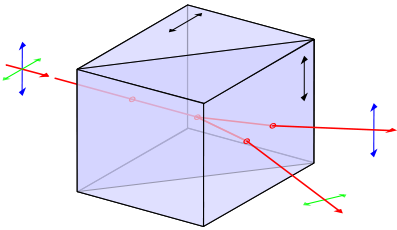
Wollaston prism
Encyclopedia

William Hyde Wollaston
William Hyde Wollaston FRS was an English chemist and physicist who is famous for discovering two chemical elements and for developing a way to process platinum ore.-Biography:...
, that manipulates polarized light
Light
Light or visible light is electromagnetic radiation that is visible to the human eye, and is responsible for the sense of sight. Visible light has wavelength in a range from about 380 nanometres to about 740 nm, with a frequency range of about 405 THz to 790 THz...
. It separates randomly polarized or unpolarized light into two orthogonal
Orthogonality
Orthogonality occurs when two things can vary independently, they are uncorrelated, or they are perpendicular.-Mathematics:In mathematics, two vectors are orthogonal if they are perpendicular, i.e., they form a right angle...
linearly polarized
Polarizer
A polarizer is an optical filter that passes light of a specific polarization and blocks waves of other polarizations. It can convert a beam of light of undefined or mixed polarization into a beam with well-defined polarization. The common types of polarizers are linear polarizers and circular...
outgoing beams.
The Wollaston prism consists of two orthogonal calcite
Calcite
Calcite is a carbonate mineral and the most stable polymorph of calcium carbonate . The other polymorphs are the minerals aragonite and vaterite. Aragonite will change to calcite at 380-470°C, and vaterite is even less stable.-Properties:...
prisms
Prism (optics)
In optics, a prism is a transparent optical element with flat, polished surfaces that refract light. The exact angles between the surfaces depend on the application. The traditional geometrical shape is that of a triangular prism with a triangular base and rectangular sides, and in colloquial use...
, cemented together on their base (traditionally with Canada balsam
Canada balsam
Canada balsam, also called Canada turpentine or balsam of fir, is a turpentine which is made from the resin of the balsam fir tree of boreal North America...
) to form two right triangle prisms with perpendicular optic axes. Outgoing light beams diverge from the prism, giving two polarized rays, with the angle of divergence determined by the prisms' wedge angle and the wavelength of the light. Commercial prisms are available with divergence angles from 15° to about 45°.
See also
- Nomarski prismNomarski prismA Nomarski prism is a modification of the Wollaston prism that is used in differential interference contrast microscopy. It is named after its inventor, Polish physicist Georges Nomarski. Like the Wollaston prism, the Nomarski prism consists of two birefringent crystal wedges cemented together at...
- Nicol prismNicol prismA Nicol prism is a type of polarizer, an optical device used to produce a polarized beam of light from an unpolarized beam. See polarized light. It was the first type of polarizing prism to be invented, in 1828 by William Nicol of Edinburgh...
- Glan–Thompson prism
- Glan–Foucault prism
- Sénarmont prismSénarmont prismThe Sénarmont prism is a type of polariser. It is made from two prisms of a birefringent material such as calcite, usually cemented together. The Sénarmont prism is named after Henri Hureau de Sénarmont...
- Rochon prismRochon prismA Rochon prism is a type of polariser. It is made from two prisms of a birefringent material such as calcite, which are cemented together.The Rochon prism was invented by and is named after Abbé Alexis Marie Rochon. It is in many ways similar to the Wollaston prism, but one ray passes through...

